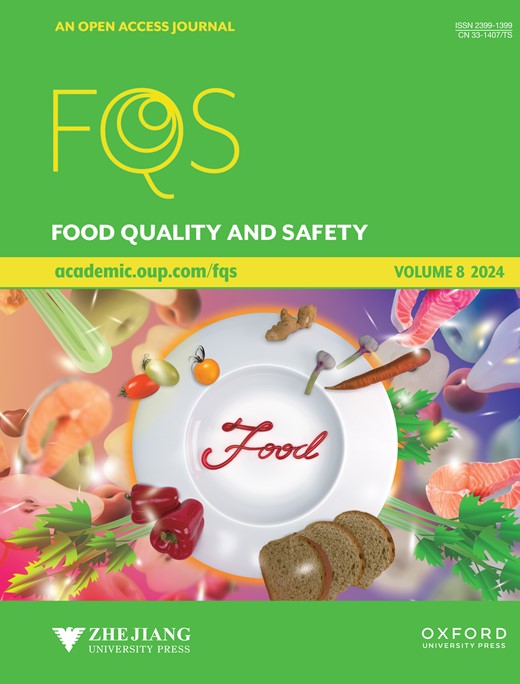紫麦和白麦粒的代谢分析和抗氧化特性比较:开发功能性小麦品种的意义
IF 4.4
3区 农林科学
Q2 FOOD SCIENCE & TECHNOLOGY
引用次数: 0
摘要
色素小麦因其较高的抗氧化活性而备受关注。本研究旨在比较紫色小麦和白色小麦的代谢成分和抗氧化特性。结果显示,与白小麦相比,紫小麦的总多酚、总黄酮和抗氧化活性水平明显更高。代谢分析采用游离、酸和碱水解三种提取方法,共鉴定出 405 种次生代谢物。值得注意的是,在不同的提取方法下,白小麦和紫小麦的次生代谢物分别为 90、80 和 73 种,差异很大。在所有组别中,糙米苷-8-C-(2''-O-葡萄糖基)葡萄糖苷、糙米苷-8-C-葡萄糖苷、二锇美汀-6-C-葡萄糖苷和莨菪苷的含量都有所下降,而芍药苷-3-O-葡萄糖苷、角叉菜苷、莪术苷氰苷-3-O-葡萄糖苷和氰苷-3-O-(6''-O-丙二酰)葡萄糖苷的含量则有所上升。这些发现表明,与花青素、黄酮和黄酮醇生物合成相关的途径受到了影响。此外,每种提取方法都发现了不同的次生代谢物。酸水解和碱水解分别上调了紫小麦中的 16 种和 3 种代谢物,上调了白小麦中的 20 种和 3 种代谢物。酸水解和碱水解还在白小麦和紫小麦中发现了吲哚-3-羧酸、香草酸、吡哆醇和其他具有抗氧化和降压作用的代谢物。这表明酸性和碱性水解能解离出更多种类和数量的差异代谢物。这些发现为育种者开发具有更多功能营养的小麦品种提供了宝贵的启示。本文章由计算机程序翻译,如有差异,请以英文原文为准。
Comparative Metabolic Analysis and Antioxidant Properties of Purple and White Wheat Grains: Implications for Developing Functional Wheat Varieties
Pigmented wheat has garnered attention due to its elevated antioxidant activity. This study aimed to compare the metabolic components and antioxidant properties of purple and white wheat grains. The results revealed that purple wheat exhibited significantly higher levels of total polyphenols, total flavonoids, and antioxidant activity compared to white wheat. Metabolic analysis identified a total of 405 secondary metabolites using three extraction methods: free, acid, and alkali hydrolysis. Notably, there were substantial variations in 90, 80, and 73 secondary metabolites between white and purple wheat under the respective extraction methods. The content of hispidulin-8-C-(2''-O-glucosyl) glucoside, hispidulin-8-C-glucoside, diosmetin-6-C-glucoside, and scoparin decreased across all groups, while the content of peonidin-3-O-glucoside, keracyanin, kuromanin cyanidin-3-O-glucoside, and cyanidin-3-O-(6''-O-malonyl) glucoside increased. These findings suggest that pathways associated with anthocyanin, flavone, and flavonol biosynthesis were influenced. Furthermore, each extraction method revealed distinct secondary metabolites. Acid and alkali hydrolysis up-regulated 16 and 3 metabolites in purple wheat, and 20 and 3 metabolites in white wheat, respectively. Acid and alkaline hydrolysis also identified indole-3-carboxylic acid, vanillic acid, pyridoxine, and other metabolites with antioxidant and antihypertensive effects in both white and purple wheat. This indicates that acid and alkaline hydrolysis can dissociate a greater variety and quantity of differential metabolites. These findings offer valuable insights for breeders seeking to develop wheat varieties with enhanced functional nutrition.
求助全文
通过发布文献求助,成功后即可免费获取论文全文。
去求助
来源期刊

Food Quality and Safety
FOOD SCIENCE & TECHNOLOGY-
CiteScore
7.20
自引率
1.80%
发文量
31
审稿时长
5 weeks
期刊介绍:
Food quality and safety are the main targets of investigation in food production. Therefore, reliable paths to detect, identify, quantify, characterize and monitor quality and safety issues occurring in food are of great interest.
Food Quality and Safety is an open access, international, peer-reviewed journal providing a platform to highlight emerging and innovative science and technology in the agro-food field, publishing up-to-date research in the areas of food quality and safety, food nutrition and human health. It promotes food and health equity which will consequently promote public health and combat diseases.
The journal is an effective channel of communication between food scientists, nutritionists, public health professionals, food producers, food marketers, policy makers, governmental and non-governmental agencies, and others concerned with the food safety, nutrition and public health dimensions.
The journal accepts original research articles, review papers, technical reports, case studies, conference reports, and book reviews articles.
 求助内容:
求助内容: 应助结果提醒方式:
应助结果提醒方式:


